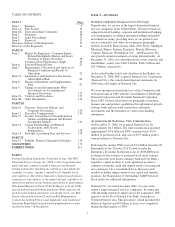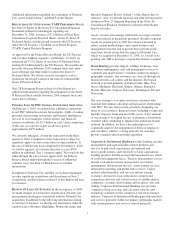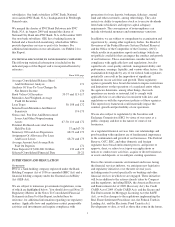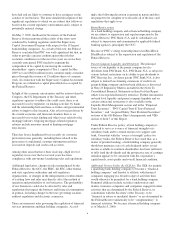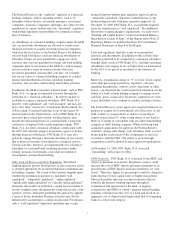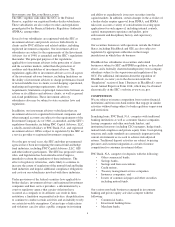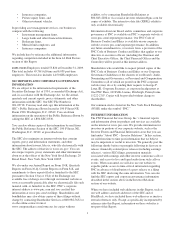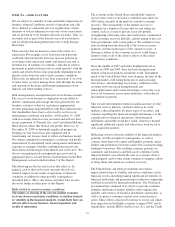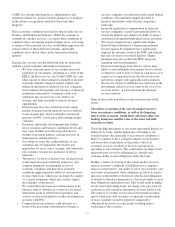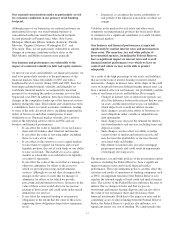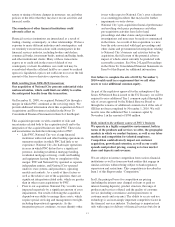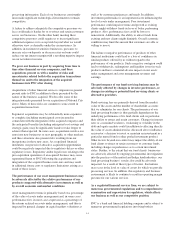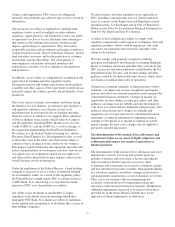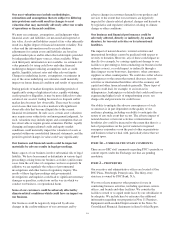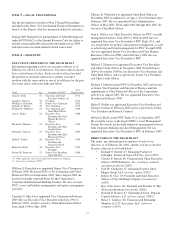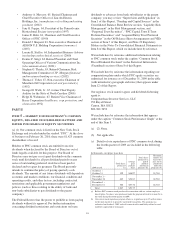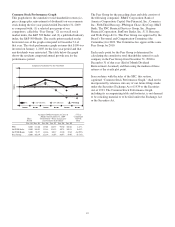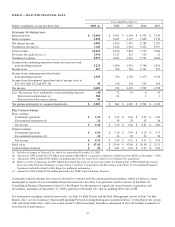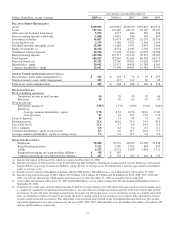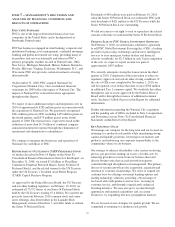PNC Bank 2009 Annual Report Download - page 16
Download and view the complete annual report
Please find page 16 of the 2009 PNC Bank annual report below. You can navigate through the pages in the report by either clicking on the pages listed below, or by using the keyword search tool below to find specific information within the annual report.Our regional concentrations make us particularly at risk
for economic conditions in our primary retail banking
footprint.
Although many of our businesses are national and some are
international in scope, our retail banking business is
concentrated within our retail branch network footprint,
located primarily in Pennsylvania, Ohio, New Jersey,
Michigan, Maryland, Illinois, Indiana, Kentucky, Florida,
Missouri, Virginia, Delaware, Washington, D.C., and
Wisconsin. Thus, we are particularly vulnerable to adverse
changes in economic conditions in these states or the
Mid-Atlantic and Midwest regions more generally.
Our business and performance are vulnerable to the
impact of continued volatility in debt and equity markets.
As most of our assets and liabilities are financial in nature, we
tend to be particularly sensitive to the performance of the
financial markets. Since the middle of 2007 and with a
heightened level of activity during 2008 and 2009, there has
been unprecedented turmoil, volatility and illiquidity in
worldwide financial markets, accompanied by uncertain
prospects for sustaining the modest economic recovery that
began mid-year 2009. In addition, there have been dramatic
changes in the competitive landscape of the financial services
industry during this time. This turmoil and volatility has been
a contributory factor to overall economic conditions, leading
to some of the risks discussed above, including impairing the
ability of borrowers and other counterparties to meet
obligations to us. Financial market volatility also can have
some of the following adverse effects on PNC and our
business and financial performance:
• It can affect the value or liquidity of our on-balance
sheet and off-balance sheet financial instruments.
• It can affect the value of servicing rights, including
those we carry at fair value.
• It can affect, to the extent we access capital markets
to raise funds to support our business and overall
liquidity position, the cost of such funds or our ability
to raise such funds. The inability to access capital
markets at a desirable cost could affect our liquidity
or results of operations.
• It can affect the value of the assets that we manage or
otherwise administer for others or the assets for
which we provide processing and information
services. Although we are not directly impacted by
changes in the value of assets that we manage or
administer for others or for which we provide
processing and information services, decreases in the
value of those assets would affect our fee income
relating to those assets and could result in decreased
demand for our services.
• It can affect the required funding of our pension
obligations to the extent that the value of the assets
supporting those obligations drops below minimum
levels.
• In general, it can impact the nature, profitability or
risk profile of the financial transactions in which we
engage.
Volatility in the markets for real estate and other assets
commonly securing financial products has been and is likely
to continue to be a significant contributor to overall volatility
in financial markets.
Our business and financial performance is impacted
significantly by market interest rates and movements in
those rates. The monetary, tax and other policies of
governmental agencies, including the Federal Reserve,
have a significant impact on interest rates and overall
financial market performance over which we have no
control and which we may not be able to predict
adequately.
As a result of the high percentage of our assets and liabilities
that are in the form of interest-bearing or interest-related
instruments, changes in interest rates, in the shape of the yield
curve or in spreads between different market interest rates can
have a material effect on our business, our profitability and the
value of our financial assets and liabilities. For example:
• Changes in interest rates or interest rate spreads can
affect the difference between the interest that we earn
on assets and the interest that we pay on liabilities,
which impacts our overall net interest income.
• Such changes can affect the ability of borrowers to
meet obligations under variable or adjustable rate
debt instruments.
• Such changes may decrease the demand for interest-
rate based products and services, including loans and
deposit accounts.
• Such changes can also affect our ability to hedge
various forms of market and interest rate risk and
may decrease the profitability or increase the risk
associated with such hedges.
• Movements in interest rates also affect mortgage
prepayment speeds and could result in impairments
of mortgage servicing assets.
The monetary, tax and other policies of the government and its
agencies, including the Federal Reserve, have a significant
impact on interest rates and overall financial market
performance. These governmental policies can thus affect the
activities and results of operations of banking companies such
as PNC. An important function of the Federal Reserve is to
regulate the national supply of bank credit and market interest
rates. The actions of the Federal Reserve influence the rates of
interest that we charge on loans and that we pay on
borrowings and interest-bearing deposits and can also affect
the value of our on-balance sheet and off-balance sheet
financial instruments. Both due to the impact on rates and by
controlling access to direct funding from the Federal Reserve
Banks, the Federal Reserve’s policies also influence, to a
significant extent, our cost of funding. We cannot predict the
12


